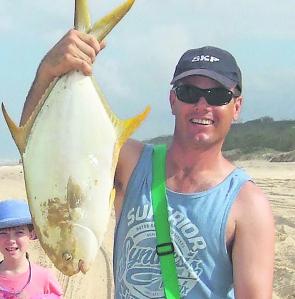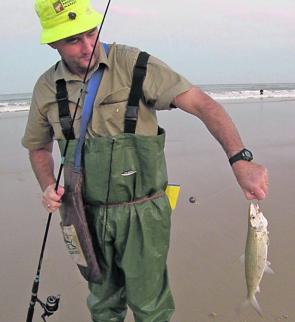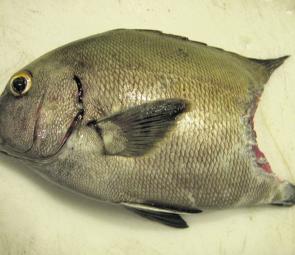In the January column we had a look at the species commonly taken along the beaches and headlands of Fraser Island. Certainly whiting, bream, tarwhine, dart, mulloway, flathead and tailor would make up at least 95% of captures, but what about the other 5%? Only seven species make up the proposed 95% but there are at least as many making up the rest.
The snub-nosed dart, also known as the oyster crusher or permit, can produce a lot of excitement along the eastern beach when you hook up with light gear intended for whiting. Not quite the experience of sight-fishing permit with fly gear on one of the world’s famous flats, but possibly close enough to give the lucky angler an unforgettable experience.
As most snub-nosed dart are taken in gutters along long stretches of beach, after a long and powerful fight, the angler is able to bring it to shore, provided the spool is adequately provisioned. More than likely, the bait would be pipi, their natural food. They pick up pipis that are washed out of the beach, and crush them with ease.
They appear to travel in small schools as, when one is taken, there is a good chance that others will be hooked in the vicinity. Taken up to 8kg along Fraser’s eastern beach, those that are not released make excellent table fare.
There are a number of species of trevally taken along the beaches and around the headlands. Although a few are taken quite by accident, the majority are taken by anglers set up with suitable equipment. The better fish are taken by anglers spinning with heavy metals around the headlands and over the coffee rocks when conditions are favourable.
Although large tailor might be the expected outcome, trevally, mostly GT are not at all unexpected. The precarious front ledges at Indian Head and the ‘wall’ at Waddy Point are popular with anglers chasing GT and other predators such as queenfish and Spanish mackerel. Along the western beaches marauding trevallies and mackerel often make raids into dense schools of hardiheads, but the angler needs to be quick enough to get a lure or fly amongst them before they disappear.
Golden trevally, however, can be a more reliable proposition as they are seen tailing over the flats, particularly around Moon Point and inside and around Wathumba Creek. Fly fishers frequently come to these and other flats within Hervey Bay to test their skills on goldies.
Bonefish, that Holy Grail of wand wavers, are sometimes taken along the beaches of Fraser Island. Until quite recently most reports have been coming in from the northern end of the island, particularly between Sandy Cape and Rooney Point. It has come as something of a surprise to see them turning up along other island beaches in recent years.
They are certainly an accidental capture when a whiting angler, after a long fight, thinks he has caught the mother of all whiting. I recall hearing that a guest angler had pulled in a 1.5kg whiting. My reaction was, “This I need to see!” Of course the weight was right but the fish was a bone. They might be superficially similar to whiting but they are much more slender, have a short section of dorsal fin and a very pronounced fork tail.
Another distinctive feature is the under-slung mouth. If you are lucky enough to score a bone on the island, enjoy the moment, take a quick photo, give him a kiss and let him go. Don’t even think about how they would go in the pan. As their name suggests, they would be less than terrible.
The headlands and coffee rocks of the island provide habitats for a number of reef dwellers. Around the headlands, rocks rarely extend far into the sea so the fish are always directly under the base of the rocks, or in the narrow gorges. This is not always easy places to fish.
Obviously snagging is a problem, and when a big fish is hooked, there is a distinct possibility of being cut off. At the southern end of Waddy Point there are good rock faces and a narrow gorge that fishes well provided it is not sanded up. On the northern side of Waddy Point, there are good opportunities at the ‘wall’ and along the northern face, and front, of the main gorge. At Indian Head, the ledge on the northern face can be worthwhile, but not during the tailor season, as you might not even get a spot.
Middle Rocks, between Waddy Point and Indian Head, has some great structure for chasing reef species. However Middle Rocks is now a designated green zone with complete prohibition of fishing.
Coffee rocks are remnants of ancient swamps where sand and organic matter have been compressed, buried, and much later exposed by erosion. A number of these formations are almost permanently exposed, others sometimes and others very rarely on both eastern and western beaches. Some such as those at One Tree Rocks, north of Eurong, are rarely seen today but in earlier years became a hindrance to beach travel. The most prominent, and mostly exposed to some extent, are at Browns Rocks and Ngkala Rocks, between Orchid Beach and Sandy Cape, Yidney and Poyungan Rocks, between Happy Valley and Eurong.
There are two species of sweetlip (blubber-lip) frequenting the rocks of the ocean beach. The gold spot blubber-lip, known locally as spotted perch, appears to have a preference for coffee rocks while the sombre or sooty blubber-lip, known locally as bruin, is found both around coffee rocks and headlands of the island’s eastern coast.
Both species prefer pipi and worm baits rather than cut baits and pilchards. Their movements between offshore coffee rocks and those inshore remain something of a mystery to me. They are closely related to the blackall that is common over Hervey Bay’s sandstone, coral and coffee rock reefs. However it is rare to find them on the coffee rocks of the western beach, or inside Hervey Bay.
At least two species of sea perch are taken around Fraser’s rocks. Moses perch and stripeys are common catches while the beautiful Maori sea perch makes an occasional appearance. The sea perches can be caught on pipis and worms but they also love flesh baits. Other occasional captures include grass sweetlip and small snapper.
The coffee rock formations of the western beach are better known for bream and flathead but blackall, grass sweetlip, small cod and purple tuskfish sometime turn up.
The potato cod is well known as the huge fish that inhabits certain Barrier Reef locations. Videos of this huge cod showing its comfort in allowing cleaner wrasses to remove parasites from mouth and gills are well known to most of us.
What is of particular interest is that juveniles are being caught in increasing numbers around the coffee rocks along the eastern coast of the island. One of the many I have caught was taken from the hole at the end of the Maheno wreck.
Of course at any size these beautiful fish are totally protected and must be returned to the water immediately.
Minimum Lengths and Bag Limits
| Species | Min. cm | Bag |
|---|---|---|
| Bonefish | - | - |
| Gold spotted blubber-lip (spotted perch) | 25 | 5 |
| Grass sweetlip | 30 | 10 |
| Moses perch | 25 | 5 |
| Potato cod | NO TAKE | PROTECTED |
| Purple tusk-fish (greasy) | 30 | 6 |
| Snapper | 35 | 4 |
| Snub-nosed dart (permit) | - | - |
| Sombre blubber-lip (bruin) | 25 | 5 |
| Stripey | 25 | 5 |
| Trevally (all sp) | - | 20 |

Stan Younger with a decent snub-nosed dart at Poyungan Valley

Small bonefish caught at Poyungan Rocks.

The head of this bruin, a reminder that munchies cruise the inshore waters.

Juvenile potato cod from Maheno wreck.




